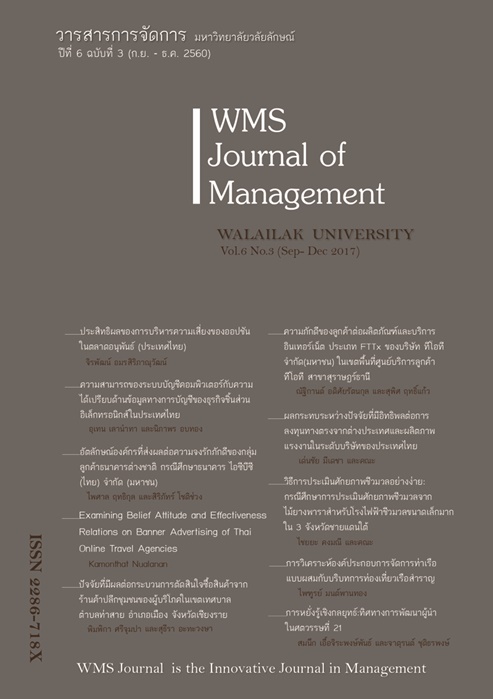An Effect between Factors Influencing Foreign Direct Investment to Labour Productivity in Firm Level of Thailand
Main Article Content
Abstract
The purposes of this study are to develop the model and examine the Causal Relationship of factors influencing Foreign Direct Investment to Labor Productivity in the multinational company which direct investment in Thailand from 433 samples of foreign senior executives. The statistical methods for analyzing data are Confirmatory Factor Analysis and Structural Equation Modeling analysis.
The research result found that the 2 main factors influencing Foreign Direct Investment are Competitiveness Advantage of Host Country and Internal Motivation in Company.
The result of Structural Equation Modeling analysis showed that the factors influencing Foreign Direct Investment also have positive influence on Labor Productivity. The most influential factor is Seeking for Resources followed by Comparative Cost and Income Changes, Save from Logistical and Business Transactional Cost, Avoid Trade Barriers, and Exchange Rate respectively. Therefore, related agency should promote and secure the stability of resources or raw materials used in the operation, build up the competitive advantage (e.g. promote and support Tax or non-Tax privileges), improve logistic and business transaction system (e.g. development of transportation network, process of coordination, regulations and procedures , or implementation of business operation), support and reduce barriers related to imported duties (e.g. imported raw materials, reducing or eliminating duties on imported machineries, or the barriers of the standards of products manufactured in Thailand), and stabilization of the exchange rate not to fluctuate too much.Article Details
References
กระทรวงแรงงาน. (2548). ผลิตภาพแรงงาน. กรุงเทพฯ: ฝ่ายวิชาการ กลุ่มงานพัฒนาระบบรายได้ และค่าจ้างขั้นต่ำ สำนักงานปลัดกระทรวงแรงงาน สำนักนโยบายและยุทธศาสตร์.
คณะกรรมการส่งเสริมการลงทุน. (2557). BOI Promoted companies directory 2014 - 2015. Investor Club Association.
สำนักงานคณะกรรมการพัฒนาการเศรษฐกิจและสังคมแห่งชาติ. (2551). ผลิตภาพการผลิต การ พัฒนาเศรษฐกิจของไทย. ใน เอกสารประกอบการสัมมนาประจำปี 2551 สายงาน เศรษฐกิจมหภาคและบัญชีประชาชาติ. กรุงเทพฯ: สำนักงานคณะกรรมการ
พัฒนาการเศรษฐกิจและสังคมแห่งชาติ.
ธนาคารแห่งประเทศไทย. (2553). ดัชนีผลิตภาพแรงงานของไทย (Labour productivity index). เข้าถึงได้จากhttps://www.bot.or.th/Thai/Statistics/
Articles/Doc_Lib_statisticsHorizon/labour%20productivity%20Index.pdf
ธนาคารแห่งประเทศไทย. (2556, เมษายน-มิถุนายน). จากรากฐานการเงินอันแข็งแกร่งสู่อนาคต เศรษฐกิจไทยก้าวหน้าอย่างยั่งยืน. วารสารพระสยาม, ฉบับที่ 2. เข้าถึงได้จาก
https://www.bot.or.th/Thai/Phrasiam/Documents/Phrasiam_2_2556/no.%204.pdf
ประชา วสุประสาท. (2553). วาระนโยบายแรงงานข้ามชาติของประเทศไทย: เส้นทางสู่
ความสามารถในการแข่งขันระยะยาว.เข้าถึงได้จาก
http://www.ilo.org/wcmsp5/groups/public/---asia/---ro-bangkok/---sro- bangkok/documents/publication/wcms_145133.pdf
เอกสิทธิ์ กาญจนาภิญโญกุล. (2554). เกร็ดความรู้ธุรกิจ: ผลิตภาพแรงงาน (Labor Productivity). เข้าถึงได้จากhttps://www.scbeic.com/THA/document
/knowledge_labor_productivity/
Abdalla, K. (2008). Jargon_alert: Productivity. Retrieved from www.academia.edu/4697588/Jargon_alert_Productivity
Asia News Monitor. (2009). Thailand: Foreign investors reluctant to invest in Thailand after political unrest. Bangkok: Thai News Service Group.
Anwar, S., & Sun, S. (2014). Heterogeneity and curvilinearity of FDI-related productivity spillovers in China's manufacturing sector. Economic Modelling, 41, 23-32.
Bijsterbosch, M., & Kolasa, M. (2010). FDI and productivity convergence in Central and Eastern Europe: An industry-level investigation. Springer, Rev World Econ No.145, 689-712.
Bruhn, N. C. P., & Calegario, C. L. L. (2014, Jan.-Mar.). Productivity spillovers from foreign direct investmentin the Brazilian
processing industry. BAR, Rio de Janeiro, 11(1), 22-46.
Chung, W. C. (1997). Foreign direct investment’s effect on host industry competition and productivity in the US: The influence of initial host industry competition and forieng firm method of entry. MI: UMI A Bell & Howell Information Company.
Daniels, J. D., & Radebaugh, L. H. (2001). International business: Environment and operations (9th ed.). Upper Saddle River, New Jersey: Prentice-Hall.
Dana, L. P., Welpe, I. M., Han, M., & Ratten, V. (2008). Handbook of research on european business and entrepreneurship: Towards a theory of internationalization. Massachusetts: Edward Elgar.
Dunning, J. H., & Lundan, S. M. (2008). Multinational enterprises and the global economy (2nded.). Northampton, Massachusetts: Edward Elgar.
Denisia, V. (2010, December). Foreign direct investment theories: An overview of the main FDI theories. European Journal of Interdisciplinary Studies, 2(2), 104-110.
Elmawazini, K., Saadi, S., & Ibrahim, N. (2005, Mar). Does FDI imply productivity growth for the host economy?. Journal of American Academy of Business, 6(2), 85.
Filiz, K. (2014, March). FDI and total factor productivity relations: An empirical analysis for BRIC and Turkey. Advances in Management, 7(3), 23-27.
Gandolfo, G. (2014). International trade theory and policy (2nd ed.). New York: Springer Heidelberg.
Liu, X., Parker, D., Vaidya, K., & Wei, Y. (2001). The impact of foreign direct investment on labour productivity in the Chinese
electronics industry. International Business Review, 10, 421-439.
Liargovas, P. G., & Skandalis, K. S. (2011). Foreign direct investment and trade openness: The case of developing economics. Soc Indic Res, 106, 323-331.
Lim, Y. (1999). Technology and productivity: The Korean way of learning and catching up. Cambridge: MIT Press.
Mao, H. (1999). Estimating labour productivity using fuzzy set theory. Ml: UMI., Bell & Howell Information and Learning.
Moosa, I. A. (2002). Foreign direct investment: Theory, evidence and practice. New York: Houndmills, Basingstoke.
Negara, S. D., & Adam, L. (2012). Foreign direct investment and firms’ productivity level lesson learned from Indonesia. ASEAN Economic Bulletin, 29(2), 116-27.
Ozawa, T. (2005). Institutions, industrial upgrading, and economic performance in Japan: The ‘flying-geese’ paradigm of catch-up growth. Massachusetts: Edward Elgar.
Ramasamy, B., & Yeung, M. (2010). A causality analysis of the FDI-wages-productivity nexus in China. Journal of Chinese Economic and Foreign Trade Studies,3(1), 5-23.
Rugman, A. M., Collinson, S., & Hodgetts, R. M. (2006). International business (4th ed.).
Harlow: Pearson Education Limited. Salvatore, D. (2013). nternational economics (11th ed.). MA: Wiley.
Stefanovic, S. (2008). Analitical framework of FDI determinants: Implementation of the OLI model. Facta Universitatis, Series: Economics and Organization, 5(3), 239-249.
UNCTAD. (2014). World investment report 2014: investing in the sdgs: An action plan. Retrieved from http://unctad.org/en/PublicationsLibrary/wir2014_en.pdf
Yamane, T. (1973). Statiatice: An introduction analysis (3rded.). New York: Harper & ow.
Zhu, G., & Tan, K. Y. (2000). Foreign direct investment and labor productivity: New evidence from China as the host. Thunderbird International Business Review, 42(5), 507-28.
Zhu, G., & Tan, K. Y. (2000). Foreign direct investment and labor productivity: New evidence from China as the host. Thunderbird International Business Review, 42(5), 507-28.


